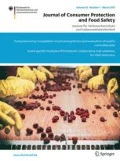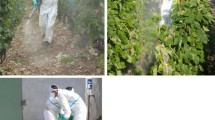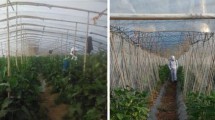Abstract
Within the European Union (EU) regulatory framework, plant protection products (PPPs) must be evaluated according to Regulation (EC) No 1107/2009. Bystander/resident exposures can be assessed using the current EU harmonised predictive EFSA model; however, the number of experimental data included in this model is rather limited. In the experimental study conducted, direct dermal and inhalation exposures of bystanders/residents caused by the spray drift during vine foliar application using sprayer equipment fitted with an anti-drift device were quantified. The exposure levels measured during the experimental exposure study were compared to those calculated using the BROWSE model, the former German model, and the EFSA model. The measured direct dermal exposure levels of bystanders/residents were found to be lower than the exposure levels calculated with the BROWSE model using the 95th percentiles [experimental study/BROWSE model (%): 3.9% and 2.1%, respectively for adults and children], and using the 75th percentiles (16% and 7.8%, respectively for adults and children), the German model using the 95th percentiles [experimental study/German model (%): 4.0% and 12%, respectively for adults and children], and much lower than those calculated with the EFSA model using the 95th percentiles [experimental study/EFSA model (%): 0.27% and 0.40% for adults and children, respectively] and using the 75th percentiles (0.51% and 0.62%, respectively for adults and children). Exposure levels via the inhalation route represented less than 1.7% of dermal exposures. The results of this experimental exposure study could be used to refine the bystander/resident exposure estimates provided by the EFSA model.



Similar content being viewed by others
References
BROWSE Project (2014) Bystanders, Residents, Operators and Workers Exposure models for plant protection products. EU 7th Framework Programme. https://secure.fera.defra.gov.uk/browse/software/. Accessed 3 June 2019
Butler Ellis MC, Miller PCH (2010) The Silsoe spray drift model: a model of spray drift for the assessment of non-target exposures to pesticides. Biosyst Eng 107:169–177. https://doi.org/10.1016/j.biosystemseng.2010.09.003
Butler Ellis MC, Lane AG, O’Sullivan CM, Miller PCH, Glass CR (2010) Bystander exposure to pesticide spray drift: new data for model development and validation. Biosyst Eng 107:162–168. https://doi.org/10.1016/j.biosystemseng.2010.05.017
Butler Ellis MC, Lane AG, O’Sullivan CM, Alanis R, Harris A, Stallinga H, Van de Zande JC (2014) Bystander and resident exposure to spray drift from orchard applications: field measurements, including a comparison of spray drift collectors. Asp Appl Biol 122:187–194
Butler Ellis MC, van de Zande JC, van den Berg F, Kennedy MC, O’Sullivan CM, Jacobs CM, Fragkoulis G, Spanoghe P, Gerritsen-Ebben R, Frewer LJ, Charistou A (2017) The BROWSE model for predicting exposures of residents and bystanders to agricultural use of plant protection products: an overview. Biosyst Eng 154:92–104. https://doi.org/10.1016/j.biosystemseng.2016.08.017
EFSA (European Food Safety Authority) (2014) Guidance on the assessment of exposure of operators, workers, residents and bystanders in risk assessment for plant protection products. EFSA J 12(10):3874
EFSA Panel on Plant Protection Products and their Residues (2010) Scientific opinion on preparation of a guidance document on pesticide exposure assessment for workers, operators, bystanders and residents. EFSA J 8(2):1501
Ganzelmeier H, Rautmann D, Spangenberg R, Streloke M, Herrmann M, Wenzelburger HJ, Walter HF (1995) Studies on the spray drift of plant protection products: results of a test program carried out throughout the Federal Republic of Germany. Blackwell, Berlin. ISSN 0067-5849. ISBN 3-8263-3039-0
Hoffmann WC, Fritz BK, Thornburg JW, Bagley WE, Birchfield NB, Ellenberger J (2010) Spray drift reduction evaluations of spray nozzles using a standardized testing protocol. ASTM Int 7(8):1–8. https://doi.org/10.1520/JAI102820
Kasiotis KM, Glass CR, Tsakirakis AN, Machera K (2014) Spray drift reduction under Southern European conditions: a pilot study in the Ecopest Project in Greece. Sci Total Environ 479–480:132–137. https://doi.org/10.1016/j.scitotenv.2014.01.088
Kennedy MC, Butler Ellis MC (2017) Probabilistic modelling for bystander and resident exposure to pesticides using the Browse software. Biosyst Eng 154:105–121. https://doi.org/10.1016/j.biosystemseng.2016.08.012
Kennedy MC, Butler Ellis MC, Miller PCH (2012) BREAM: a probabilistic bystander and resident exposure assessment model of spray drift from an agricultural boom sprayer. Comput Electron Agric 88:63–71. https://doi.org/10.1016/j.compag.2012.07.004
Lewis KA, Tzilivakis J (2017) Review of the published exposure data to pesticides for residents and bystanders, and for environmental risk assessment: final report. EFSA supporting publication 2017. https://efsa.onlinelibrary.wiley.com/doi/epdf/10.2903/sp.efsa.2017.EN-1204. Accessed 19 Oct 2019
Lloyd GA, Bell GJ (1983) Hydraulic nozzles: comparative spray drift study. Agricultural Development and Advisory Service, Ministry of Agriculture Fisheries and Food, London
Lloyd GA, Bell GJ, Samuels SW, Cross JV, Berry AM (1987) Orchard sprayers: comparative operator exposure and spray drift study. Agricultural Science Service, Agricultural Development and Advisory Service, Ministry of Agriculture Fisheries and Food, London
Martin S, Westphal D, Erdtmann-Vourliotis M, Dechet F, Schulze-Rosario C, Stauber F, Wicke H, Chester G (2008) Guidance for exposure and risk evaluation for bystanders and residents exposed to plant protection products during and after application. J Verbrauch Lebensm 3:272–281. https://doi.org/10.1007/s00003-008-0361-5
Matthews G, Hamey P (2003) Exposure of bystanders to pesticides. Pestic Outlook 14:210–212. https://doi.org/10.1039/B311469B
Note de service DGAL/SDQSPV/2016-686 (2016) Inscription au Bulletin officiel du ministère de l’agriculture et de l’agroalimentaire et de la forêt des moyens permettant de diminuer la dérive des produits visés à l’article L.253-1 du Code rural et de la pêche maritime pour les milieux aquatiques. https://info.agriculture.gouv.fr/gedei/site/bo-agri/instruction-2016-686. Accessed 19 Oct 2019
OECD (1997) Guidance document for the conduct of studies of occupational exposure to pesticides during agricultural application. Environmental Health and Safety Publications Series on Testing and Assessment No 9, OCDE/GD (97) 148. http://www.oecd.org/officialdocuments/publicdisplaydocumentpdf/?cote=ocde/gd(97)148&doclanguage=en. Accessed 19 Oct 2019
PROPULPPP (2019) Objectivation de l’exposition des populations aux pulvérisations de produits phytopharmaceutiques en Wallonie et des mesures de protection destinées à limiter cette exposition.http://www.cra.wallonie.be/fr/propulppp. Accessed 11 Jan 2020
Rautmann D, Streloke M, Winkler R (2001) New basic drift values in the authorisation procedure of pesticides. In: Workshop on Risk Assessment and Risk Mitigation Measures in the Context of Authorisation of Pesticides (WORMM). Mitt. Biol. Bundesanst. Land-Forstwirtsch. Berlin-Dahlem, Heft 381, Berlin. ISSN 0067-5849. ISBN 3-8263-3359-4
Ryberg MW, Rosenbaum RK, Mosqueron L, Fantke P (2018) Addressing bystander exposure to agricultural pesticides in life cycle impact assessment. Chemosphere 197:541–549. https://doi.org/10.1016/j.chemosphere.2018.01.088
van de Zande JC, Butler Ellis MC, Wenneker M, Walklate PJ, Kennedy MC (2014) Spray drift and bystander risk from fruit crop spraying. Asp Appl Biol 122:177–185
Acknowledgements
The author would like to thank I. Thouvenin from HUMEXPO, acting as study director of the field study.
Funding
ANSES—French Agency for Food, Environmental and Occupational Health & Safety. Funding was provided by Agence Nationale de Sécurité Sanitaire de l’Alimentation, de l’Environnement et du Travail.
Author information
Authors and Affiliations
Corresponding author
Ethics declarations
Conflict of interest
The author declares that he has no conflict of interest.
Additional information
Publisher's Note
Springer Nature remains neutral with regard to jurisdictional claims in published maps and institutional affiliations.
Disclaimer The findings and conclusions in this report are those of the author and do not necessarily represent the views of ANSES.
Electronic supplementary material
Below is the link to the electronic supplementary material.
Rights and permissions
About this article
Cite this article
Mercier, T. Direct dermal and inhalation exposure of bystanders and residents during vine foliar application using sprayer equipment fitted with an anti-drift device: a comparison between measured exposure levels and existing exposure models. J Consum Prot Food Saf 15, 219–227 (2020). https://doi.org/10.1007/s00003-020-01274-1
Received:
Revised:
Accepted:
Published:
Issue Date:
DOI: https://doi.org/10.1007/s00003-020-01274-1




